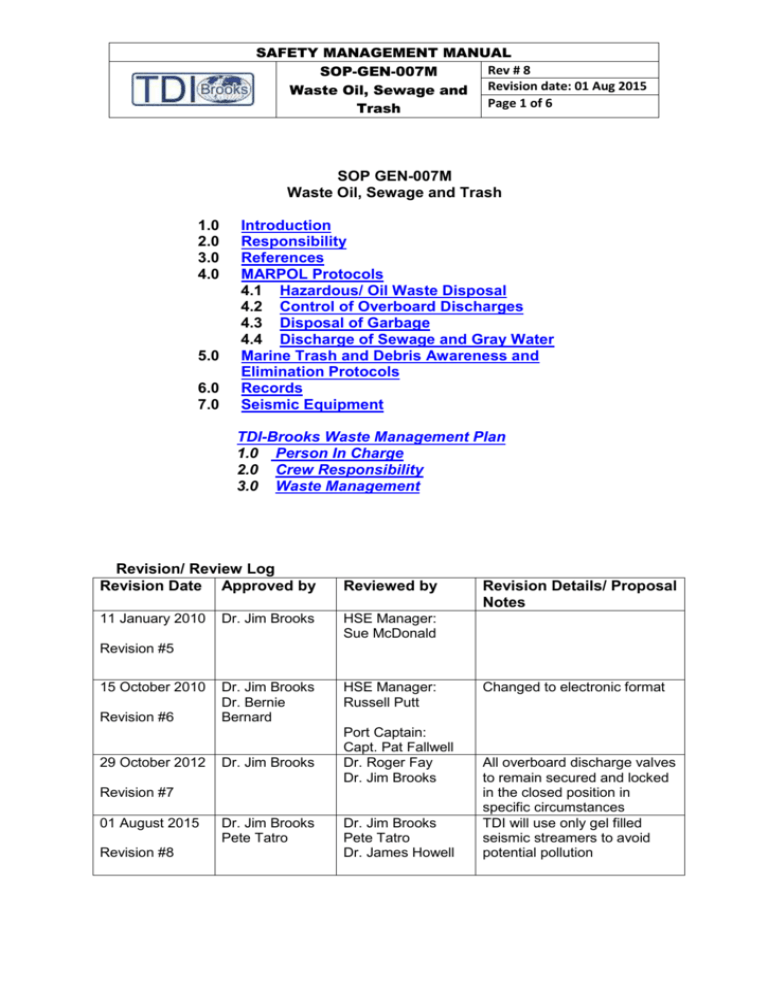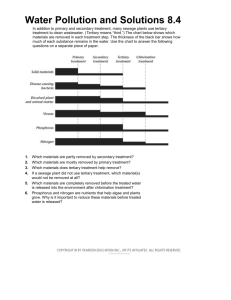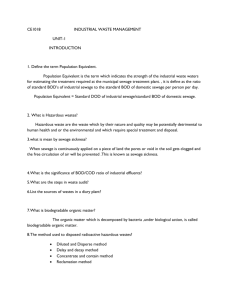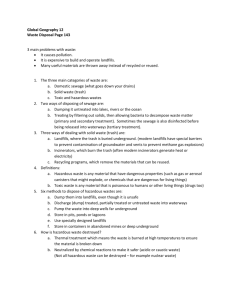sop-gen-007m Waste Oil Sewage and Trash rev8
advertisement

SAFETY MANAGEMENT MANUAL Rev # 8 SOP-GEN-007M Waste Oil, Sewage and Revision date: 01 Aug 2015 Page 1 of 6 Trash SOP GEN-007M Waste Oil, Sewage and Trash 1.0 2.0 3.0 4.0 5.0 6.0 7.0 Introduction Responsibility References MARPOL Protocols 4.1 Hazardous/ Oil Waste Disposal 4.2 Control of Overboard Discharges 4.3 Disposal of Garbage 4.4 Discharge of Sewage and Gray Water Marine Trash and Debris Awareness and Elimination Protocols Records Seismic Equipment TDI-Brooks Waste Management Plan 1.0 Person In Charge 2.0 Crew Responsibility 3.0 Waste Management Revision/ Review Log Revision Date Approved by 11 January 2010 Reviewed by Dr. Jim Brooks HSE Manager: Sue McDonald Dr. Jim Brooks Dr. Bernie Bernard HSE Manager: Russell Putt Revision Details/ Proposal Notes Revision #5 15 October 2010 Revision #6 29 October 2012 Dr. Jim Brooks Port Captain: Capt. Pat Fallwell Dr. Roger Fay Dr. Jim Brooks Revision #7 01 August 2015 Revision #8 Dr. Jim Brooks Pete Tatro Dr. Jim Brooks Pete Tatro Dr. James Howell Changed to electronic format All overboard discharge valves to remain secured and locked in the closed position in specific circumstances TDI will use only gel filled seismic streamers to avoid potential pollution SAFETY MANAGEMENT MANUAL Rev # 8 SOP-GEN-007M Waste Oil, Sewage and Revision date: 01 Aug 2015 Page 2 of 6 Trash 1.0 Introduction This SOP describes the policies and procedures for handling waste oil, sewage, and trash aboard TDI-Brooks vessels. TDI-Brooks follows the guidelines established in MAROL 1973, as amended in 1978 and any local requirements. Oil waste is collected and stored in an oily waste tank on board the vessel. It is processed through an oily water separator after which water may then be discharged. Oily waste may also be stored on board until pick up by an approved oily waste collector in port. Trash may be separated and stored on the vessel until disposal by an approved collector in port. Sewage is stored and processed or discharged according to MARPOL 1973/78 standards. No hazardous waste is discharged at sea. Other wastes may be disposed at sea only in accordance with MARPOL 1973/78 guidelines. It is TDI-Brooks’ policy that no trash or debris is thrown overboard. 2.0 Responsibility The master is ultimately responsible for the management of wastes on this vessel. The chief mate is responsible for the management of wastes. The chief mate will ensure that all crew understand the waste management plan and the need to be in compliance with international, state, and local rules and regulations. The chief engineer is responsible for the maintenance and operation of the waste oil and sewage system. All crewmembers and science/technical party members are responsible for familiarizing themselves and complying with the waste management plan. 3.0 References International Convention for the Prevention of Pollution from Ships, 1973, as amended by the Protocol of 1978 (MARPOL) 30 CFR 250.300 (a) and (b)(6) 30 CFR 250.300 (c) Vessel SOPEP SAFETY MANAGEMENT MANUAL Rev # 8 SOP-GEN-007M Waste Oil, Sewage and Revision date: 01 Aug 2015 Page 3 of 6 Trash 4.0 MARPOL Protocols All wastes will be handled in the proper manner so to comply with International Convention for the Prevention of Pollution from Ships, 1973, as amended by the Protocol of 1978 (MARPOL) and all appropriate federal, state and local regulations. MARPOL regulations include the following: 4.1 Hazardous/Oil Waste Disposal The disposal of hazardous/oil wastes from this vessel will follow guidelines established by MARPOL, specifically: Paint wastes, thinners and other hazardous wastes will be separated from other waste and contained in marked containers until they can be disposed of at appropriate facilities. Aerosol cans will be stored in a separate container and labeled as “Aerosol Cans” and held until proper disposal can be arranged. Waste oil filters will be placed in a waste container and labeled as “Waste Oil Filter” and held until proper disposal can be arranged. No waste oil and/or water-oil wastes will be pumped into the sea unless it meets MARPOL standards. Oily wastes (including cooking oil) will be separated from other wastes and contained until they can be disposed of at appropriate facilities. Bilge water will not be pumped overboard unless it has been processed through an approved oil/water separator. No chemical will be discharged into the sea. Hazardous waste containers will be marked. Records of on board hazardous/oil wastes will be maintained. 4.2 Control of Overboard Discharges Sewage - 40 CFR 140. 3 and 140.4 requires that overboard discharges of sewage (directly or from MSD Type III) be secured and the valve locked when in state waters (within 3 miles of shore). Further, treated discharges are prohibited (and valves must be secured and locked) from Type I and II MSD in special areas defined by EPA (e.g. Florida Keys National Marine Sanctuary). Overboard discharge valves of treated or untreated sewage will be secured and locked when the vessel is operating in these conditions. A sign to this effect will be posted at the respective valves. Hazardous Materials – 33 CFR 156.120(h) During the transfer of hazardous materials (in the case of TDI Brooks Fleet – bunkering operations and the disposal of oily bilge or waste oil to a shore side receiving facility) each SAFETY MANAGEMENT MANUAL Rev # 8 SOP-GEN-007M Waste Oil, Sewage and Revision date: 01 Aug 2015 Page 4 of 6 Trash overboard discharge or sea suction valve that is connected to the vessel’s transfer system must be secured and locked in the closed position. Overboard discharge valves and sea suction valves connected to the bilge/ballast system will be secured and locked when the vessel is operating in these conditions. A sign to this effect will be posted at the respective valves. Oily Water Separator – The overboard discharge valve from the oily water separator is to be secured and locked when the vessel is in a special area (MARPOL Annex 1 Regulation 10), when the vessel is less than 12 nm from shore, not underway proceeding en route, or when the OWS is inoperative (and so indicated in the ORB). 4.3 Disposal of Garbage Disposal of garbage will follow guidelines established by MARPOL, specifically: 4.4 The disposal into the sea of all plastics, including but not limited to synthetic ropes, synthetic fishing nets, and plastic garbage bags is prohibited. The disposal into the sea of the following garbage shall be made as far as practicable from the nearest land but in any case is prohibited if the distance from the nearest land is less than: 25 nautical miles for dunnage, lining and packing materials which will float; 12 nautical miles for food wastes and all other garbage including paper products, rags, glass, metal, bottles, crockery and similar refuse. The disposal into the sea of food wastes may be permitted when it has passed through a comminuter or grinder and made as far as practicable from the nearest land but in any case is prohibited if the distance from the nearest land is less than 3 nautical miles. Such comminuted or ground garbage shall be capable of passing through a screen with openings no greater than 25 millimeters. Exceptions to these guidelines are described by MARPOL. Discharge of Sewage and Gray Water The discharge of sewage and gray water will follow guidelines established by MARPOL (see Appendix E), specifically: The discharge of sewage and gray water into the sea is prohibited, except when the ship is discharging comminuted and disinfected sewage/gray water using an approved system at a distance of more than 4 nautical miles from the nearest land, or sewage which is not comminuted or disinfected at a distance of more than 12 nautical miles from the nearest land, provided that in any case, the sewage/gray water that has been stored in holding tanks shall SAFETY MANAGEMENT MANUAL Rev # 8 SOP-GEN-007M Waste Oil, Sewage and Revision date: 01 Aug 2015 Page 5 of 6 Trash 5.0 not be discharged instantaneously but at a moderate rate when the ship is en route and proceeding at not less than 4 knots; the rate of discharge shall be approved; or The ship has in operation an approved sewage treatment plant which has been certified; or the ship is situated in the waters under the jurisdiction of a State and is discharging sewage in accordance with such less stringent requirements as may be imposed by such State. When the sewage is mixed with wastes or wastewater having different discharge requirements, the more stringent requirements shall apply. Exceptions to these guidelines are described by MARPOL. Marine Trash and Debris Awareness and Elimination Protocols The Marine Trash and Debris Awareness and Elimination policy is specific for the Gulf of Mexico and is designed to protect marine animals, prevent damage to vessels and prevent unsightly litter of the coastline. Since the oil and gas operations in the Gulf of Mexico contribute to this chronic problem, 30 CFR 250.300 (a) and (b)(6) prohibit the deliberate discharging of containers and similar materials (i.e., trash and debris) into the marine environment. 30 CFR 250.300 (c) requires durable identification markings on equipment, tools and containers (especially drum), and other material. Furthermore, the intentional jettisoning of trash has been the subject of strict laws such as MARPOL-Annex V and the Marine Plastic Pollution Research and Control Act, and regulations imposed by various agencies including the United States Coast Guard (USCG) and the Environmental Protection Agency (EPA).” Marine debris is defined as any object or fragment of wood, metal, glass, rubber, plastic, cloth, paper or any other man-made item or material that is lost or discarded in the marine environment. 6.0 Records No trash or debris is discarded over the vessel at sea. It is stored on board until it can be disposed in port by a reputable vendor. Stored oil wastes and hazardous wastes are only disposed in port by a reputable waste handler. Records must be maintained of all waste pick-ups. 7.0 Seismic Equipment TDI-Brooks will only use gel filled streamers for seismic survey to avoid potential pollution. SAFETY MANAGEMENT MANUAL Rev # 8 SOP-GEN-007M Waste Oil, Sewage and Revision date: 01 Aug 2015 Page 6 of 6 Trash TDI-Brooks Waste Management Plan The following is the Company waste management plan policies and should be posted on board the vessel. Shipboard wastes (trash, sewage, gray water, oily wastes, food scraps, and hazardous materials) are governed by U.S. and international laws and regulations. This vessel strives to meet these laws and regulations. Failure to do so may result in significant fines. Consequently, the following is the shipboard waste management plan for this vessel. 1.0 Person in Charge The master has designated the chief mate as the person in charge of the waste management plan. The chief mate shall: 2.0 Ensure that the vessel waste management plan is in compliance with all required laws, rules, and regulations Administer the waste management plan Brief all crew members and science/technical party members on the waste management policy Maintain records of all waste pick ups and disposal Crew Responsibility All crew members and science/technical staff members shall familiarize themselves and comply with the waste management policy. Any questions and/or concerns shall be directed to the chief mate. Each department head (chief mate, chief engineer, winch operator, and party chief) shall ensure that all individuals under their supervision comply with the waste management plan. 3.0 Waste Management It is not permitted to throw any trash or debris (including cigarette butts) overboard this vessel. Hazardous wastes are stored separately in adequate containers. Oily wastes are stored separately in adequate containers. Separate food wastes from other types of refuse. Food wastes may be disposed of overboard by the galley crew only at approved distances from shore Sewage may be disposed of overboard by the engineers only at approved distances from shore.






